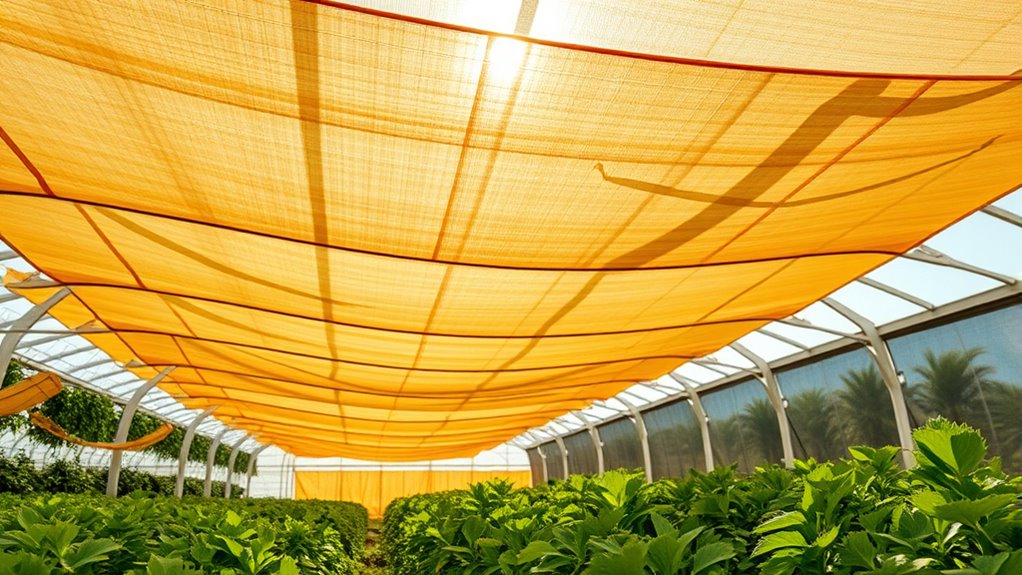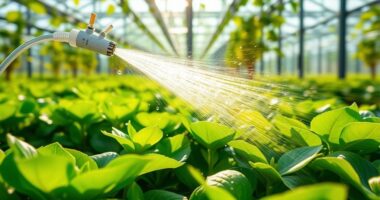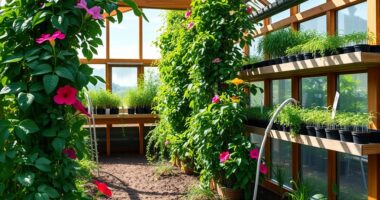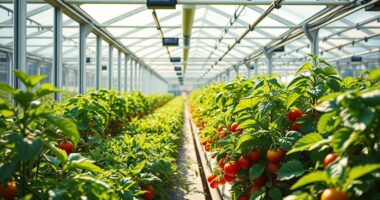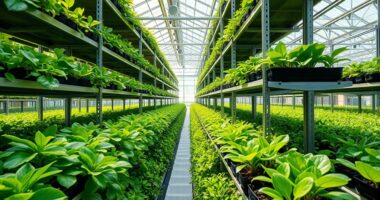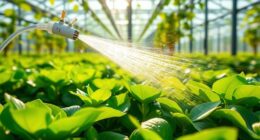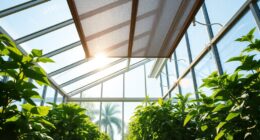To effectively cool your greenhouse during summer, combine reflective surfaces like white paint, shields, or coatings with internal shading panels. Reflective materials bounce sunlight away and reduce heat gain, while internal shade cloths diffuse sunlight and lower leaf temperatures. Using both methods creates a layered defense against heat buildup, minimizing energy use for cooling and protecting your plants from stress. To discover more strategies for maintaining a cooler greenhouse environment, keep exploring these techniques.
Key Takeaways
- Use reflective shields and white-painted surfaces to bounce sunlight away and reduce heat gain.
- Apply reflective coatings on greenhouse roofs or walls to lower heat transfer and interior temperatures.
- Install internal shading panels or reflective shade cloths to diffuse sunlight and lower leaf temperatures.
- Combine external reflective surfaces with internal shading for layered, effective cooling during summer.
- Position reflective materials strategically to maximize sunlight reflection and minimize heat entry into the greenhouse.
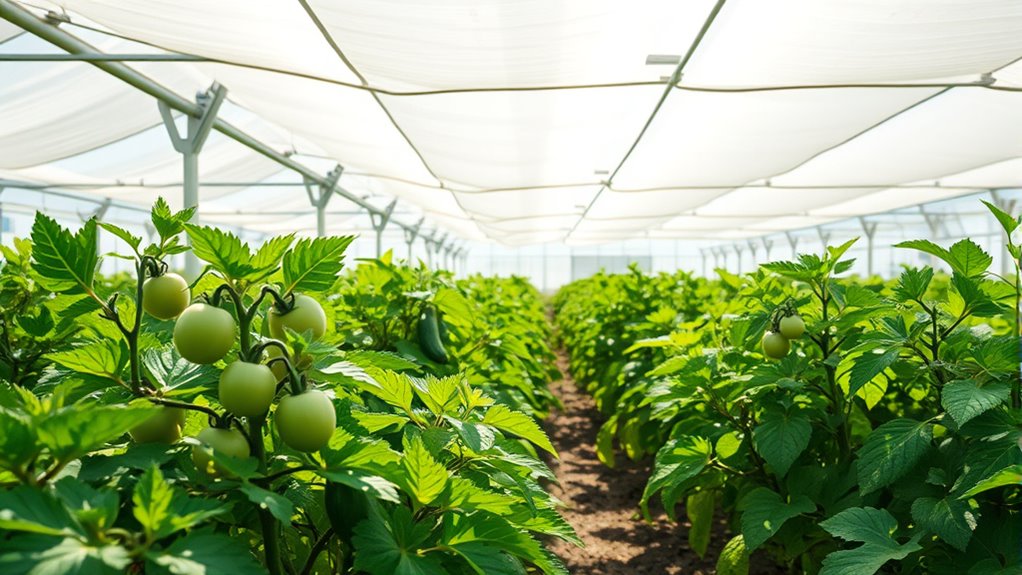
As summer temperatures soar, maintaining ideal conditions inside your greenhouse becomes increasingly challenging. One of the key factors influencing internal temperature is plant transpiration, which naturally cools plants by releasing moisture into the air. However, during the hottest days, this process alone might not suffice to keep your greenhouse comfortable. To enhance cooling, you can incorporate reflective materials as part of your shading strategy. These materials bounce sunlight away from the greenhouse, reducing heat gain and helping maintain a more stable environment for your plants.
Using reflective materials is a straightforward way to minimize heat absorption. Placing reflective shields or white-painted surfaces around your greenhouse’s exterior can considerably decrease the amount of solar radiation that enters. These surfaces reflect a substantial portion of the sun’s rays, preventing them from heating up the greenhouse interior excessively. When combined with natural plant transpiration, reflective materials create a synergy that keeps temperatures more manageable. While transpiration cools plants directly, the reflective surfaces limit the initial heat influx, making your cooling efforts more effective overall.
Reflective shields and white surfaces reduce heat entry, enhancing natural transpiration for cooler greenhouse conditions.
In addition to external reflective surfaces, consider applying reflective coatings on the greenhouse roof or walls. These coatings are designed specifically to reflect sunlight, reducing the heat transfer into your space. Not only do they help during peak summer heat, but they also contribute to energy savings by lessening the need for additional cooling systems. When you use reflective materials thoughtfully, you create a layered defense against heat buildup—reducing the workload on fans, vents, or misting systems.
Another useful tip is to strategically position reflective shade cloths or panels inside your greenhouse. Hanging these materials above plants can shield them from direct sunlight, especially during the hottest parts of the day. This internal shading minimizes plant transpiration stress by diffusing sunlight and lowering leaf temperatures. Plus, since these materials reflect rather than absorb heat, they help keep the ambient temperature down without adding moisture or weight to your structure. Incorporating reflective surfaces into your overall cooling strategy enables a more efficient and effective way to manage summer heat.
Ultimately, combining plant transpiration benefits with reflective materials creates a highly effective shading technique for summer greenhouse cooling. You’re not just blocking sunlight but actively managing how much heat enters and stays inside. By choosing the right reflective surfaces and positioning them wisely, you’ll provide a cooler, more stable environment that promotes healthy plant growth even during the warmest months. This integrated approach ensures your greenhouse remains productive, energy-efficient, and resilient against the intense summer heat.
Frequently Asked Questions
Can Shading Techniques Be Used During Winter to Regulate Temperature?
Yes, shading techniques can help with winter temperature regulation by preventing heat loss during colder months. You can use seasonal shading strategies like installing thermal curtains or reflective materials that retain warmth at night and block excessive cold. These methods allow you to optimize your greenhouse’s climate year-round, ensuring plants stay healthy without overheating or losing too much heat, making shading a versatile tool for winter as well as summer.
How Do Shading Materials Impact Plant Growth and Health?
Shading materials directly impact your plant canopy and light penetration, influencing growth and health. By reducing excessive light, they prevent leaf scorch, stress, and dehydration. Proper shading allows ideal light levels, encouraging healthy photosynthesis and strong development. If you choose the right shading, you’ll promote a balanced environment that supports vigorous growth, enhances disease resistance, and ensures your plants thrive during hot summer months.
Are There Eco-Friendly Shading Options Suitable for Sustainable Greenhouses?
Think of eco-friendly shading options as the green shields protecting your plants. Solar textiles are a fantastic choice—they block excess heat while allowing light and air to pass through. Biodegradable shading materials also work wonders, breaking down naturally without harming the environment. These sustainable options help keep your greenhouse cool and healthy, ensuring your plants thrive while you stay true to eco-conscious gardening.
What Are the Cost Differences Between Various Shading Methods?
You’ll find that shade cloths are generally the most affordable, making them ideal for tight budgets. Retractable shading systems cost more upfront but offer flexibility, leading to potential savings over time. Automated systems have higher initial costs but provide precise control and efficiency. When doing a cost analysis, consider your budget considerations, long-term energy savings, and how much control you need to choose the best shading method for your greenhouse.
How Does Shading Affect Humidity Levels Inside the Greenhouse?
Shading can substantially influence humidity levels, often increasing them by reducing evaporation rates. Studies show that shading can raise humidity by up to 20%, aiding evaporative cooling and humidity control. When you use shading, you create a more stable environment, preventing excessive dryness or moisture buildup. This balance helps keep your plants healthy and prevents issues like mold or dehydration, making shading a crucial part of summer greenhouse management.
Conclusion
By applying effective shading techniques, you can keep your greenhouse cooler during summer like a shield blocking out the harsh sun. These methods help regulate temperature, protect your plants, and improve growth. Remember, shading is your greenhouse’s summer sweater—lightweight yet essential. With the right strategies, you’ll create a comfortable environment, ensuring your plants thrive even when the heat is intense. Stay proactive, and your greenhouse will stay cool as a cucumber all season long.
